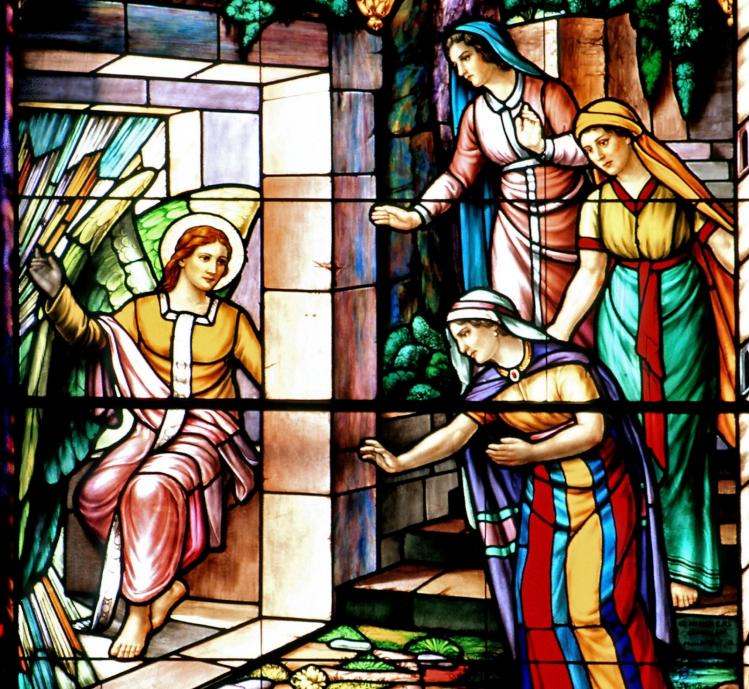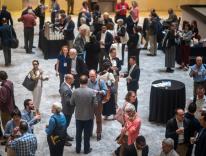
Visiting St. Peter’s Basilica for the first time a couple of years ago, I was overcome with emotion upon approaching St. Peter’s Baldachin, Gian Lorenzo Bernini’s sculpted bronze canopy below which lies the tomb of Peter himself. Being in that spot made Peter present to me in a way he had never been before. I believe it had something to do with the familial experience of visiting a tomb. Every Holy Week, I like to reflect on the Gospel reading of Jesus’s trial before the Sanhedrin and Peter’s denial of Jesus (Matthew 26:57–75). That reading of course ends with: “Then Peter remembered the word that Jesus had spoken: ‘Before the cock crows you will deny me three times.’ He went out and began to weep bitterly” (Matthew 26:75). That day in St. Peter’s Basilica, I sensed his bitter tears. Peter had been witness to all that Jesus had done; he could have stood and spoken on behalf of Jesus during the trial when “the high priest tore his robes and said, ‘He has blasphemed! What further need have we of witnesses?” (Matthew 26:65).
Peter denied Jesus because he was afraid of losing his life. One can understand the fear he felt from having witnessed Jesus being unfairly tried; he could have suffered the same fate that night. When confronted by danger, our instinct is self-preservation. I imagine that Peter wept bitterly for the loss of Jesus, for feeling that he had failed him, and for the awareness of his human frailty. Of course, we know how the story ends, and the power of Peter’s witness bears much fruit after the Resurrection. The Gospel accounts of the Resurrection depend entirely on the testimony of those who were with Jesus. When we celebrate Easter, we celebrate witness and testimony.
This past Holy Week saw the beginning of the trial of former Minneapolis police officer Derek Chauvin, charged with the second- and third-degree murder and second-degree manslaughter of George Floyd. Both the prosecution and defense are keenly aware of the power of the disturbing footage of the incident, recorded by Darnella Frazier, who was only seventeen on that day in May 2020. Frazier testified on Holy Tuesday. “When I look at George Floyd,” she told the court, “I look at my dad, I look at my brothers, I look at my cousins, my uncles, because they are all Black.” She expressed regret for not having physically intervened to help save Floyd’s life. When I heard her testimony, I thought of Peter, whose fear for his own life at the hands of the authorities kept him from attempting to save another. I felt for her grief, but I also know that her testimony, her video, has continued to move many throughout the world to work for racial justice. On Good Friday, the act of adoring the cross was intended to bring us closer to the love of Christ, which by association deepens our love for humanity. Our bitter tears are intended to help us recognize the many moments that Jesus is crucified in our society. Every instance of racism and xenophobia is the pain of the crucifixion. Good Friday asked, “Are you a witness to the pain, suffering, and beauty of the ones who our society crucifies?” Do we feel with them? Do we stand with them?
While we might be feeling as if there’s hope for an end to the pandemic, we are still far from seeing an end to hatred. On the United Nation’s International Day for the Elimination of Racial Discrimination on March 21, Pope Francis tweeted:
Racism is a virus that quickly mutates and, instead of disappearing goes into hiding, and lurks in waiting. Instances of racism continue to shame us, for they show that our supposed social progress is not as real or definitive as we think.
The shaming continues as we see an increase in anti-Asian rhetoric and violence, and as our attention shifts from the pandemic to our continued social, economic, and political ailments.
On this Easter Sunday, as we do every year at Mass, we proclaim the Easter sequence, Victimae paschali laudes, before the Gospel. Towards the middle of the sequence, we hear an exhortation to Mary Magdalene, the first witness to the Resurrection:
Speak, Mary, declaring
What you saw, wayfaring.
‘The tomb of Christ, who is living,
The glory of Jesus’ resurrection;
Bright angels attesting,
The shroud and napkin resting.
Yes, Christ my hope is arisen;
to Galilee he goes before you.’
The bitter tears on Good Friday invited us to recognize our human frailty, our failure to love, to extend justice and mercy. Christ’s Resurrection shows us the road towards salvation. It invites us into communion, to give testimony and witness to the love, justice, and mercy needed in this world, to declare what we have seen, wayfaring, and to trust that Jesus goes before us.
Please email comments to [email protected] and join the conversation on our Facebook page.
Previous Story
What We’ve Been Missing
Next Story
Minds Without Brains?


